Analyzing Friction, Emissions, and Performance in Automotive Engines
VerifiedAdded on 2020/04/01
|9
|2425
|270
AI Summary
The study focuses on understanding how friction in automotive engines can be minimized using advanced techniques, the influence of various fuels such as biodiesel on emissions, and strategies for enhancing engine performance. It includes an exploration of journal bearings under high load, lubrication behaviors, and ignition timing adjustments to improve outcomes. The assignment aims to provide a thorough analysis backed by recent research and experimental studies in the field of mechanical engineering.
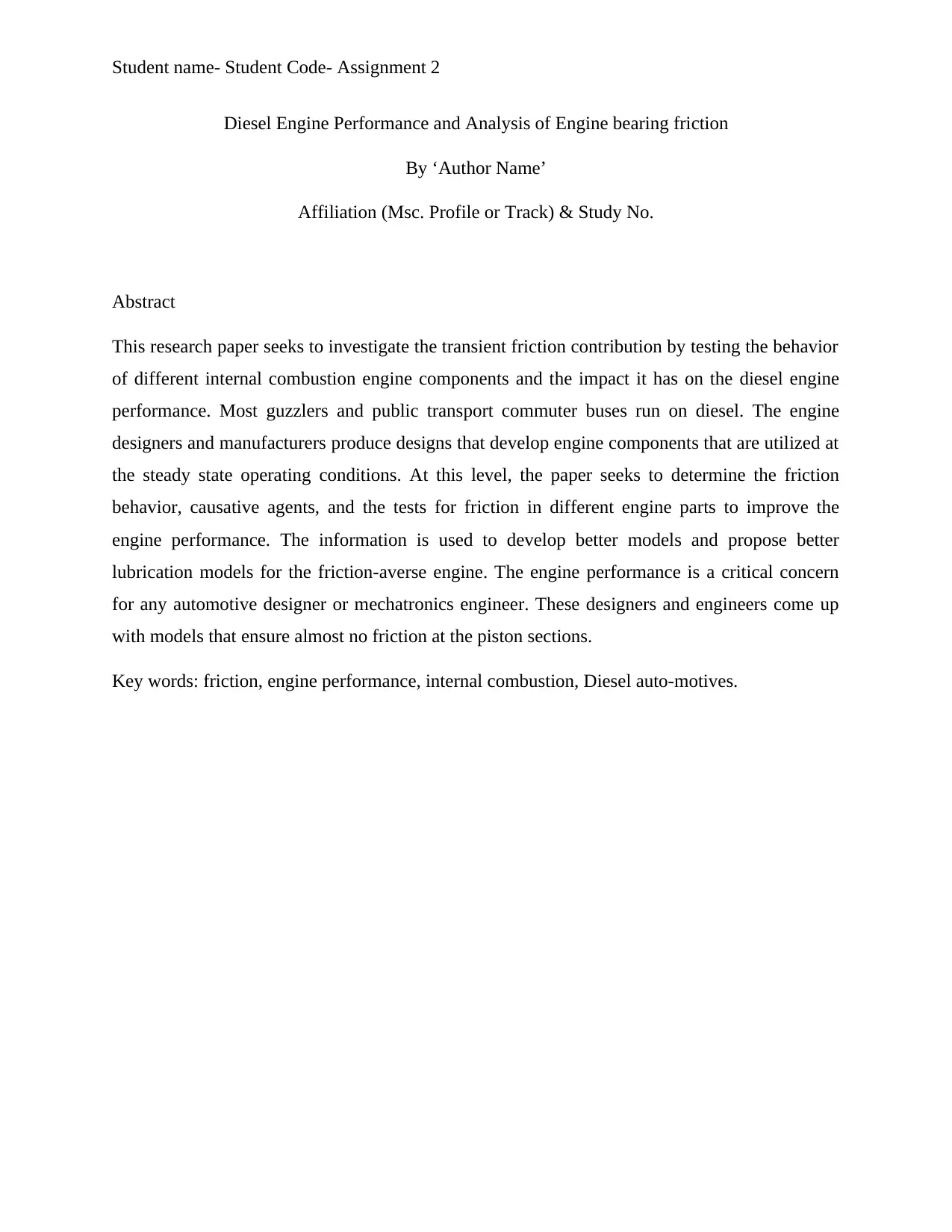
Student name- Student Code- Assignment 2
Diesel Engine Performance and Analysis of Engine bearing friction
By ‘Author Name’
Affiliation (Msc. Profile or Track) & Study No.
Abstract
This research paper seeks to investigate the transient friction contribution by testing the behavior
of different internal combustion engine components and the impact it has on the diesel engine
performance. Most guzzlers and public transport commuter buses run on diesel. The engine
designers and manufacturers produce designs that develop engine components that are utilized at
the steady state operating conditions. At this level, the paper seeks to determine the friction
behavior, causative agents, and the tests for friction in different engine parts to improve the
engine performance. The information is used to develop better models and propose better
lubrication models for the friction-averse engine. The engine performance is a critical concern
for any automotive designer or mechatronics engineer. These designers and engineers come up
with models that ensure almost no friction at the piston sections.
Key words: friction, engine performance, internal combustion, Diesel auto-motives.
Diesel Engine Performance and Analysis of Engine bearing friction
By ‘Author Name’
Affiliation (Msc. Profile or Track) & Study No.
Abstract
This research paper seeks to investigate the transient friction contribution by testing the behavior
of different internal combustion engine components and the impact it has on the diesel engine
performance. Most guzzlers and public transport commuter buses run on diesel. The engine
designers and manufacturers produce designs that develop engine components that are utilized at
the steady state operating conditions. At this level, the paper seeks to determine the friction
behavior, causative agents, and the tests for friction in different engine parts to improve the
engine performance. The information is used to develop better models and propose better
lubrication models for the friction-averse engine. The engine performance is a critical concern
for any automotive designer or mechatronics engineer. These designers and engineers come up
with models that ensure almost no friction at the piston sections.
Key words: friction, engine performance, internal combustion, Diesel auto-motives.
Paraphrase This Document
Need a fresh take? Get an instant paraphrase of this document with our AI Paraphraser
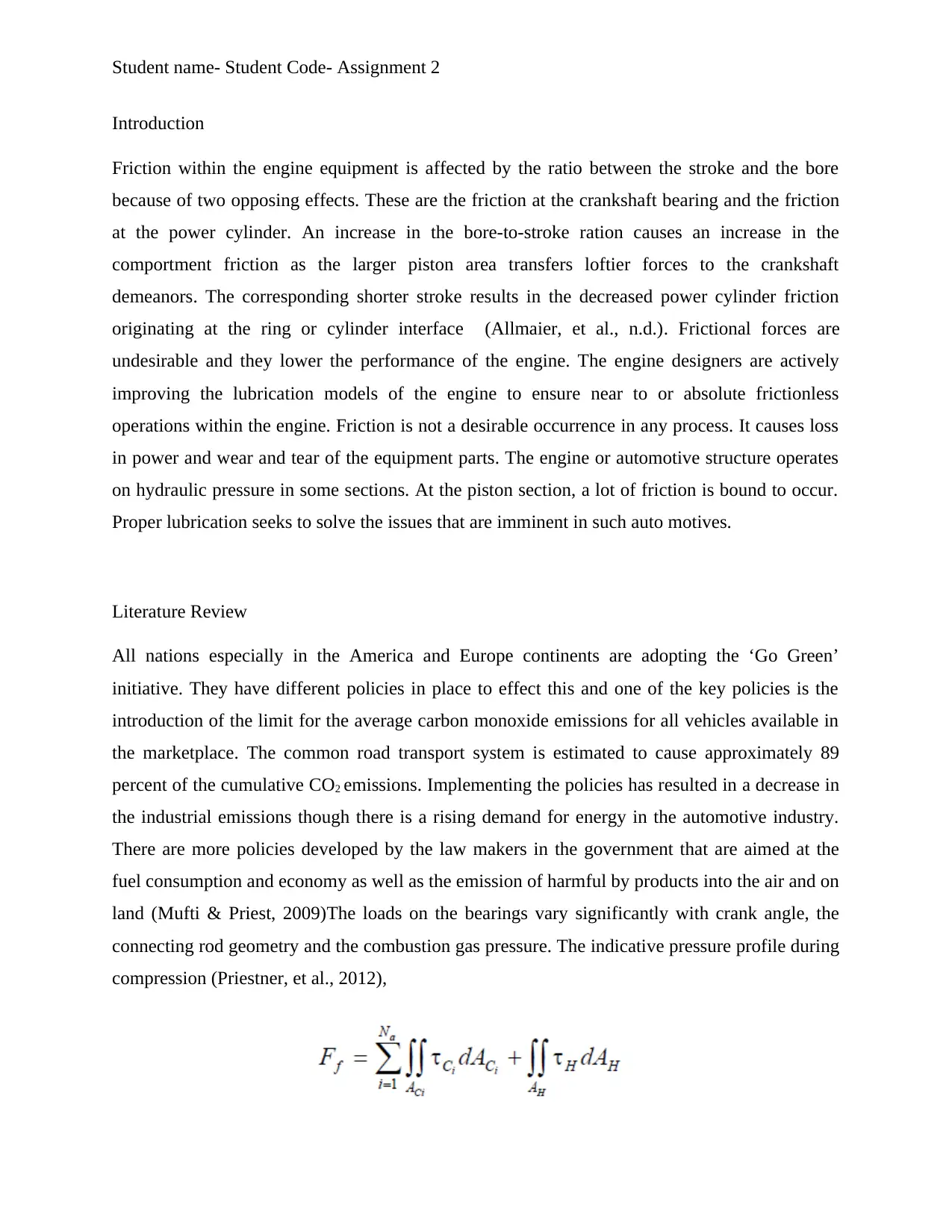
Student name- Student Code- Assignment 2
Introduction
Friction within the engine equipment is affected by the ratio between the stroke and the bore
because of two opposing effects. These are the friction at the crankshaft bearing and the friction
at the power cylinder. An increase in the bore-to-stroke ration causes an increase in the
comportment friction as the larger piston area transfers loftier forces to the crankshaft
demeanors. The corresponding shorter stroke results in the decreased power cylinder friction
originating at the ring or cylinder interface (Allmaier, et al., n.d.). Frictional forces are
undesirable and they lower the performance of the engine. The engine designers are actively
improving the lubrication models of the engine to ensure near to or absolute frictionless
operations within the engine. Friction is not a desirable occurrence in any process. It causes loss
in power and wear and tear of the equipment parts. The engine or automotive structure operates
on hydraulic pressure in some sections. At the piston section, a lot of friction is bound to occur.
Proper lubrication seeks to solve the issues that are imminent in such auto motives.
Literature Review
All nations especially in the America and Europe continents are adopting the ‘Go Green’
initiative. They have different policies in place to effect this and one of the key policies is the
introduction of the limit for the average carbon monoxide emissions for all vehicles available in
the marketplace. The common road transport system is estimated to cause approximately 89
percent of the cumulative CO2 emissions. Implementing the policies has resulted in a decrease in
the industrial emissions though there is a rising demand for energy in the automotive industry.
There are more policies developed by the law makers in the government that are aimed at the
fuel consumption and economy as well as the emission of harmful by products into the air and on
land (Mufti & Priest, 2009)The loads on the bearings vary significantly with crank angle, the
connecting rod geometry and the combustion gas pressure. The indicative pressure profile during
compression (Priestner, et al., 2012),
Introduction
Friction within the engine equipment is affected by the ratio between the stroke and the bore
because of two opposing effects. These are the friction at the crankshaft bearing and the friction
at the power cylinder. An increase in the bore-to-stroke ration causes an increase in the
comportment friction as the larger piston area transfers loftier forces to the crankshaft
demeanors. The corresponding shorter stroke results in the decreased power cylinder friction
originating at the ring or cylinder interface (Allmaier, et al., n.d.). Frictional forces are
undesirable and they lower the performance of the engine. The engine designers are actively
improving the lubrication models of the engine to ensure near to or absolute frictionless
operations within the engine. Friction is not a desirable occurrence in any process. It causes loss
in power and wear and tear of the equipment parts. The engine or automotive structure operates
on hydraulic pressure in some sections. At the piston section, a lot of friction is bound to occur.
Proper lubrication seeks to solve the issues that are imminent in such auto motives.
Literature Review
All nations especially in the America and Europe continents are adopting the ‘Go Green’
initiative. They have different policies in place to effect this and one of the key policies is the
introduction of the limit for the average carbon monoxide emissions for all vehicles available in
the marketplace. The common road transport system is estimated to cause approximately 89
percent of the cumulative CO2 emissions. Implementing the policies has resulted in a decrease in
the industrial emissions though there is a rising demand for energy in the automotive industry.
There are more policies developed by the law makers in the government that are aimed at the
fuel consumption and economy as well as the emission of harmful by products into the air and on
land (Mufti & Priest, 2009)The loads on the bearings vary significantly with crank angle, the
connecting rod geometry and the combustion gas pressure. The indicative pressure profile during
compression (Priestner, et al., 2012),
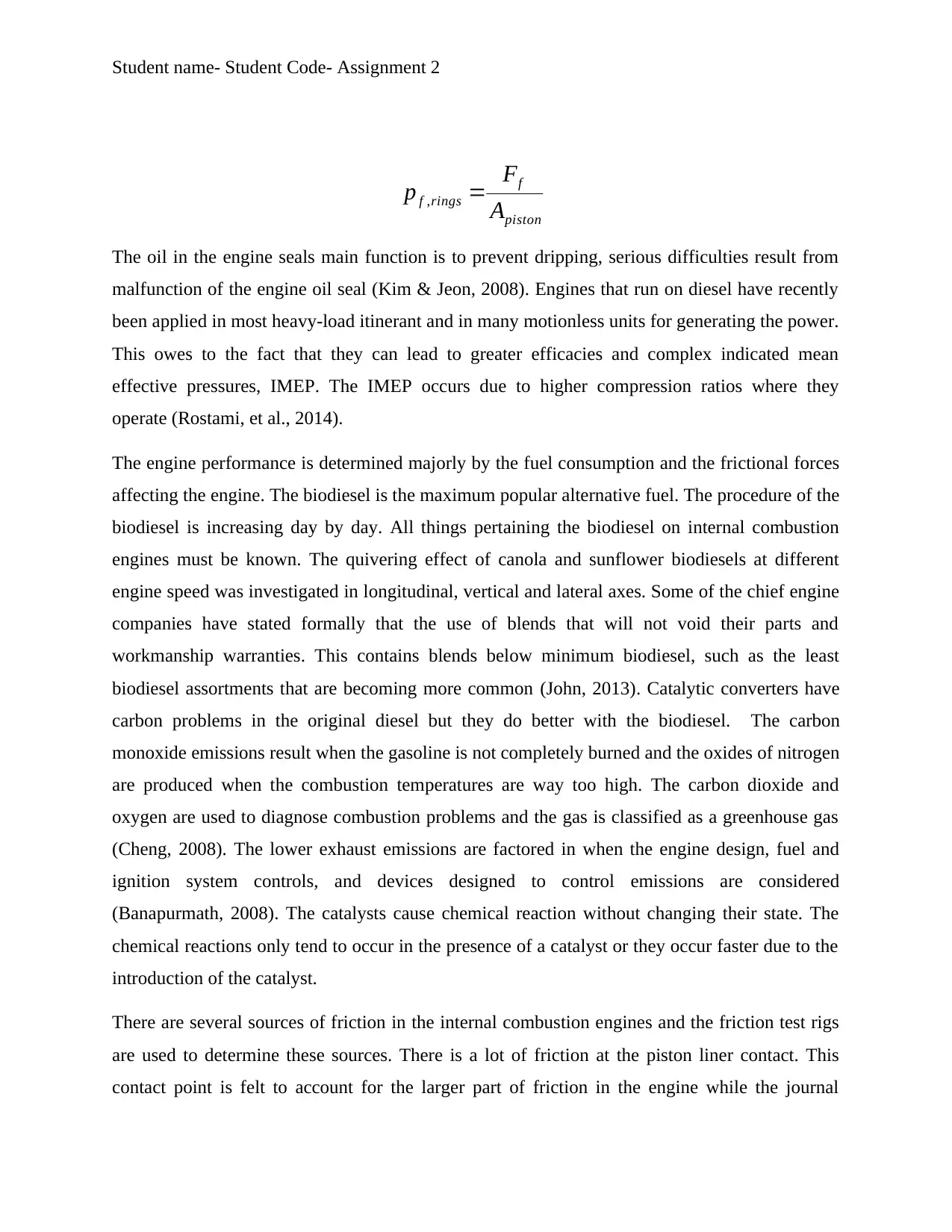
Student name- Student Code- Assignment 2
The oil in the engine seals main function is to prevent dripping, serious difficulties result from
malfunction of the engine oil seal (Kim & Jeon, 2008). Engines that run on diesel have recently
been applied in most heavy-load itinerant and in many motionless units for generating the power.
This owes to the fact that they can lead to greater efficacies and complex indicated mean
effective pressures, IMEP. The IMEP occurs due to higher compression ratios where they
operate (Rostami, et al., 2014).
The engine performance is determined majorly by the fuel consumption and the frictional forces
affecting the engine. The biodiesel is the maximum popular alternative fuel. The procedure of the
biodiesel is increasing day by day. All things pertaining the biodiesel on internal combustion
engines must be known. The quivering effect of canola and sunflower biodiesels at different
engine speed was investigated in longitudinal, vertical and lateral axes. Some of the chief engine
companies have stated formally that the use of blends that will not void their parts and
workmanship warranties. This contains blends below minimum biodiesel, such as the least
biodiesel assortments that are becoming more common (John, 2013). Catalytic converters have
carbon problems in the original diesel but they do better with the biodiesel. The carbon
monoxide emissions result when the gasoline is not completely burned and the oxides of nitrogen
are produced when the combustion temperatures are way too high. The carbon dioxide and
oxygen are used to diagnose combustion problems and the gas is classified as a greenhouse gas
(Cheng, 2008). The lower exhaust emissions are factored in when the engine design, fuel and
ignition system controls, and devices designed to control emissions are considered
(Banapurmath, 2008). The catalysts cause chemical reaction without changing their state. The
chemical reactions only tend to occur in the presence of a catalyst or they occur faster due to the
introduction of the catalyst.
There are several sources of friction in the internal combustion engines and the friction test rigs
are used to determine these sources. There is a lot of friction at the piston liner contact. This
contact point is felt to account for the larger part of friction in the engine while the journal
piston
f
ringsf A
F
p ,
The oil in the engine seals main function is to prevent dripping, serious difficulties result from
malfunction of the engine oil seal (Kim & Jeon, 2008). Engines that run on diesel have recently
been applied in most heavy-load itinerant and in many motionless units for generating the power.
This owes to the fact that they can lead to greater efficacies and complex indicated mean
effective pressures, IMEP. The IMEP occurs due to higher compression ratios where they
operate (Rostami, et al., 2014).
The engine performance is determined majorly by the fuel consumption and the frictional forces
affecting the engine. The biodiesel is the maximum popular alternative fuel. The procedure of the
biodiesel is increasing day by day. All things pertaining the biodiesel on internal combustion
engines must be known. The quivering effect of canola and sunflower biodiesels at different
engine speed was investigated in longitudinal, vertical and lateral axes. Some of the chief engine
companies have stated formally that the use of blends that will not void their parts and
workmanship warranties. This contains blends below minimum biodiesel, such as the least
biodiesel assortments that are becoming more common (John, 2013). Catalytic converters have
carbon problems in the original diesel but they do better with the biodiesel. The carbon
monoxide emissions result when the gasoline is not completely burned and the oxides of nitrogen
are produced when the combustion temperatures are way too high. The carbon dioxide and
oxygen are used to diagnose combustion problems and the gas is classified as a greenhouse gas
(Cheng, 2008). The lower exhaust emissions are factored in when the engine design, fuel and
ignition system controls, and devices designed to control emissions are considered
(Banapurmath, 2008). The catalysts cause chemical reaction without changing their state. The
chemical reactions only tend to occur in the presence of a catalyst or they occur faster due to the
introduction of the catalyst.
There are several sources of friction in the internal combustion engines and the friction test rigs
are used to determine these sources. There is a lot of friction at the piston liner contact. This
contact point is felt to account for the larger part of friction in the engine while the journal
piston
f
ringsf A
F
p ,
⊘ This is a preview!⊘
Do you want full access?
Subscribe today to unlock all pages.

Trusted by 1+ million students worldwide

Student name- Student Code- Assignment 2
bearings in the crank train account for the other percentage. The valve train is another major
source of friction and it causes the losses that equally accounts for power losses as well as its
counterpart, the journal bearings. Lubrication is one of the solutions at the metal to metal contact
points. There are several mechanical losses that are involved in the important functions (Zhang,
2002). Generally, friction is a force that occurs between two surfaces that are sliding or slipping
across one another. It always works in the opposite direction of work. The effects of friction tend
to slow down a moving object. The amount of friction experienced depends on the materials
from which the two surfaces are made. When the surfaces are very rough, much more friction is
felt than when there are smoother surfaces. Frictional forces have a by-product, heat. Excessive
heat in an engine does more harm than good especially when it is not contained. Lubrication
using oil tends to reduce friction between two surfaces that are in contact. This implies lesser
wear on the metal and minimal heat is produced from the moving parts.
Evaluation
Work consumed by compression process,
dVpW
The total work per cycle for each section of the engine, I, of the total friction is given by
assimilating the friction force, F, times its dislocation dx around the cycle,
dxFW ifif )(,,
The friction force mechanisms are either autonomous of speed or comparative to speed or its
square.
2
321 NCNCCWtf
To review the frictional impact on the diesel engine performance the following setup was
achieved by turning the internal combustion engine over. The turnover was done with the help of
the combustion using an induction motor. The system utilizes a belt drive system of about
bearings in the crank train account for the other percentage. The valve train is another major
source of friction and it causes the losses that equally accounts for power losses as well as its
counterpart, the journal bearings. Lubrication is one of the solutions at the metal to metal contact
points. There are several mechanical losses that are involved in the important functions (Zhang,
2002). Generally, friction is a force that occurs between two surfaces that are sliding or slipping
across one another. It always works in the opposite direction of work. The effects of friction tend
to slow down a moving object. The amount of friction experienced depends on the materials
from which the two surfaces are made. When the surfaces are very rough, much more friction is
felt than when there are smoother surfaces. Frictional forces have a by-product, heat. Excessive
heat in an engine does more harm than good especially when it is not contained. Lubrication
using oil tends to reduce friction between two surfaces that are in contact. This implies lesser
wear on the metal and minimal heat is produced from the moving parts.
Evaluation
Work consumed by compression process,
dVpW
The total work per cycle for each section of the engine, I, of the total friction is given by
assimilating the friction force, F, times its dislocation dx around the cycle,
dxFW ifif )(,,
The friction force mechanisms are either autonomous of speed or comparative to speed or its
square.
2
321 NCNCCWtf
To review the frictional impact on the diesel engine performance the following setup was
achieved by turning the internal combustion engine over. The turnover was done with the help of
the combustion using an induction motor. The system utilizes a belt drive system of about
Paraphrase This Document
Need a fresh take? Get an instant paraphrase of this document with our AI Paraphraser
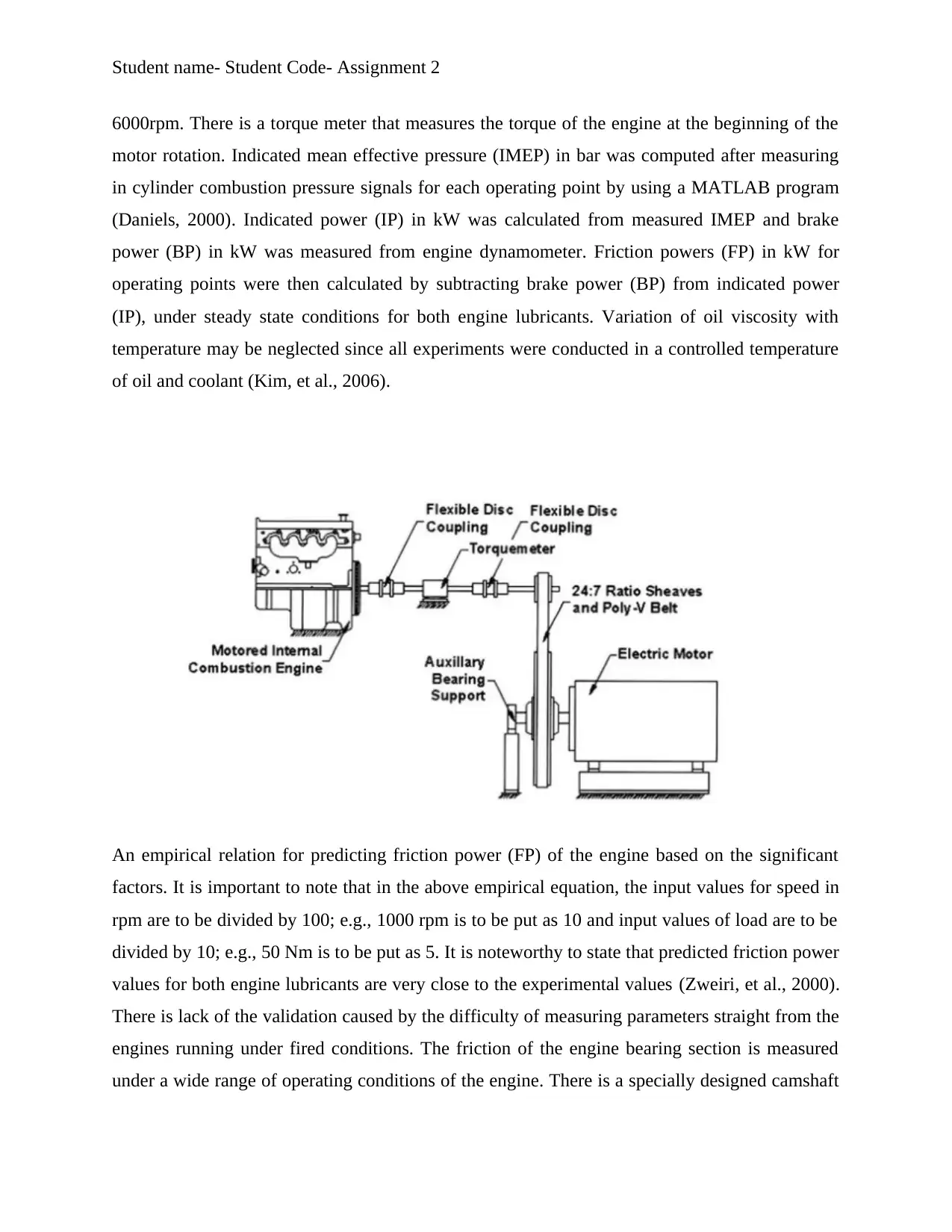
Student name- Student Code- Assignment 2
6000rpm. There is a torque meter that measures the torque of the engine at the beginning of the
motor rotation. Indicated mean effective pressure (IMEP) in bar was computed after measuring
in cylinder combustion pressure signals for each operating point by using a MATLAB program
(Daniels, 2000). Indicated power (IP) in kW was calculated from measured IMEP and brake
power (BP) in kW was measured from engine dynamometer. Friction powers (FP) in kW for
operating points were then calculated by subtracting brake power (BP) from indicated power
(IP), under steady state conditions for both engine lubricants. Variation of oil viscosity with
temperature may be neglected since all experiments were conducted in a controlled temperature
of oil and coolant (Kim, et al., 2006).
An empirical relation for predicting friction power (FP) of the engine based on the significant
factors. It is important to note that in the above empirical equation, the input values for speed in
rpm are to be divided by 100; e.g., 1000 rpm is to be put as 10 and input values of load are to be
divided by 10; e.g., 50 Nm is to be put as 5. It is noteworthy to state that predicted friction power
values for both engine lubricants are very close to the experimental values (Zweiri, et al., 2000).
There is lack of the validation caused by the difficulty of measuring parameters straight from the
engines running under fired conditions. The friction of the engine bearing section is measured
under a wide range of operating conditions of the engine. There is a specially designed camshaft
6000rpm. There is a torque meter that measures the torque of the engine at the beginning of the
motor rotation. Indicated mean effective pressure (IMEP) in bar was computed after measuring
in cylinder combustion pressure signals for each operating point by using a MATLAB program
(Daniels, 2000). Indicated power (IP) in kW was calculated from measured IMEP and brake
power (BP) in kW was measured from engine dynamometer. Friction powers (FP) in kW for
operating points were then calculated by subtracting brake power (BP) from indicated power
(IP), under steady state conditions for both engine lubricants. Variation of oil viscosity with
temperature may be neglected since all experiments were conducted in a controlled temperature
of oil and coolant (Kim, et al., 2006).
An empirical relation for predicting friction power (FP) of the engine based on the significant
factors. It is important to note that in the above empirical equation, the input values for speed in
rpm are to be divided by 100; e.g., 1000 rpm is to be put as 10 and input values of load are to be
divided by 10; e.g., 50 Nm is to be put as 5. It is noteworthy to state that predicted friction power
values for both engine lubricants are very close to the experimental values (Zweiri, et al., 2000).
There is lack of the validation caused by the difficulty of measuring parameters straight from the
engines running under fired conditions. The friction of the engine bearing section is measured
under a wide range of operating conditions of the engine. There is a specially designed camshaft
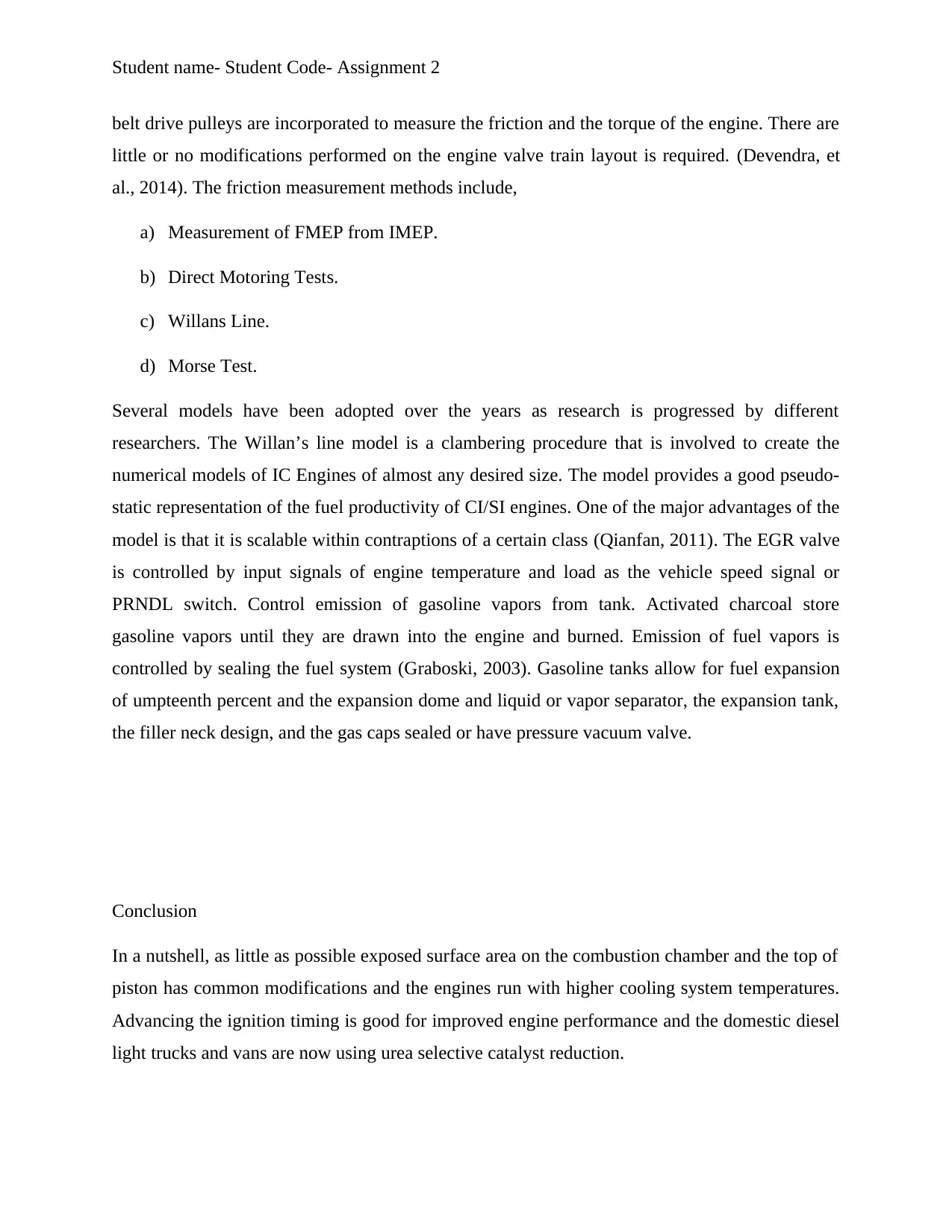
Student name- Student Code- Assignment 2
belt drive pulleys are incorporated to measure the friction and the torque of the engine. There are
little or no modifications performed on the engine valve train layout is required. (Devendra, et
al., 2014). The friction measurement methods include,
a) Measurement of FMEP from IMEP.
b) Direct Motoring Tests.
c) Willans Line.
d) Morse Test.
Several models have been adopted over the years as research is progressed by different
researchers. The Willan’s line model is a clambering procedure that is involved to create the
numerical models of IC Engines of almost any desired size. The model provides a good pseudo-
static representation of the fuel productivity of CI/SI engines. One of the major advantages of the
model is that it is scalable within contraptions of a certain class (Qianfan, 2011). The EGR valve
is controlled by input signals of engine temperature and load as the vehicle speed signal or
PRNDL switch. Control emission of gasoline vapors from tank. Activated charcoal store
gasoline vapors until they are drawn into the engine and burned. Emission of fuel vapors is
controlled by sealing the fuel system (Graboski, 2003). Gasoline tanks allow for fuel expansion
of umpteenth percent and the expansion dome and liquid or vapor separator, the expansion tank,
the filler neck design, and the gas caps sealed or have pressure vacuum valve.
Conclusion
In a nutshell, as little as possible exposed surface area on the combustion chamber and the top of
piston has common modifications and the engines run with higher cooling system temperatures.
Advancing the ignition timing is good for improved engine performance and the domestic diesel
light trucks and vans are now using urea selective catalyst reduction.
belt drive pulleys are incorporated to measure the friction and the torque of the engine. There are
little or no modifications performed on the engine valve train layout is required. (Devendra, et
al., 2014). The friction measurement methods include,
a) Measurement of FMEP from IMEP.
b) Direct Motoring Tests.
c) Willans Line.
d) Morse Test.
Several models have been adopted over the years as research is progressed by different
researchers. The Willan’s line model is a clambering procedure that is involved to create the
numerical models of IC Engines of almost any desired size. The model provides a good pseudo-
static representation of the fuel productivity of CI/SI engines. One of the major advantages of the
model is that it is scalable within contraptions of a certain class (Qianfan, 2011). The EGR valve
is controlled by input signals of engine temperature and load as the vehicle speed signal or
PRNDL switch. Control emission of gasoline vapors from tank. Activated charcoal store
gasoline vapors until they are drawn into the engine and burned. Emission of fuel vapors is
controlled by sealing the fuel system (Graboski, 2003). Gasoline tanks allow for fuel expansion
of umpteenth percent and the expansion dome and liquid or vapor separator, the expansion tank,
the filler neck design, and the gas caps sealed or have pressure vacuum valve.
Conclusion
In a nutshell, as little as possible exposed surface area on the combustion chamber and the top of
piston has common modifications and the engines run with higher cooling system temperatures.
Advancing the ignition timing is good for improved engine performance and the domestic diesel
light trucks and vans are now using urea selective catalyst reduction.
⊘ This is a preview!⊘
Do you want full access?
Subscribe today to unlock all pages.

Trusted by 1+ million students worldwide

Student name- Student Code- Assignment 2
References
Allmaier, H., Priestner, C., Sander, D. E. & Reich, F. M., n.d. Friction in Automotive Engines.
[Online]
Available at: http://dx.doi.org/10.5772/51568
Banapurmath, N. R., 2008. Experimental Investigations of a four-stroke single cyclinder direct
injection diesel Engine operated on dual fuel mode with producer gas as inducted fuel and Honge
oil and its methyl ester (HOME) as injected fuels. Renewable Energy, Volume 33, pp. 2007-
2018.
Cheng, C. H., 2008. Comparison of emissions of a direct injection diesel engine operating on
biodiesel with emulsified and fumigated methanol. Fuel, Volume 87, pp. 1870-1879.
Daniels, C. C., 2000. The Transient Behaviour of Friction components in an Internal Combustion
Engine. PhD Dissertation, University of Akron, Akron, OH.
Devendra, S. et al., 2014. Prediction and Analysis of engine Friction Power of a Diesel Engine
Influenced by Engine Speed, Load, And Lubricant Viscosity. New York: s.n.
Graboski, M., 2003. The Effect of Biodiesel composition on engine emissions from a DDC series
60 Diesel Engine, s.l.: NREL SR-510-31461.
John, D., 2013. Manufacturere warranty information. [Online]
Available at:
http://www.biodiesel.org/resources/fuelfactsheets/standards_and_warranties.shtm#statements
References
Allmaier, H., Priestner, C., Sander, D. E. & Reich, F. M., n.d. Friction in Automotive Engines.
[Online]
Available at: http://dx.doi.org/10.5772/51568
Banapurmath, N. R., 2008. Experimental Investigations of a four-stroke single cyclinder direct
injection diesel Engine operated on dual fuel mode with producer gas as inducted fuel and Honge
oil and its methyl ester (HOME) as injected fuels. Renewable Energy, Volume 33, pp. 2007-
2018.
Cheng, C. H., 2008. Comparison of emissions of a direct injection diesel engine operating on
biodiesel with emulsified and fumigated methanol. Fuel, Volume 87, pp. 1870-1879.
Daniels, C. C., 2000. The Transient Behaviour of Friction components in an Internal Combustion
Engine. PhD Dissertation, University of Akron, Akron, OH.
Devendra, S. et al., 2014. Prediction and Analysis of engine Friction Power of a Diesel Engine
Influenced by Engine Speed, Load, And Lubricant Viscosity. New York: s.n.
Graboski, M., 2003. The Effect of Biodiesel composition on engine emissions from a DDC series
60 Diesel Engine, s.l.: NREL SR-510-31461.
John, D., 2013. Manufacturere warranty information. [Online]
Available at:
http://www.biodiesel.org/resources/fuelfactsheets/standards_and_warranties.shtm#statements
Paraphrase This Document
Need a fresh take? Get an instant paraphrase of this document with our AI Paraphraser
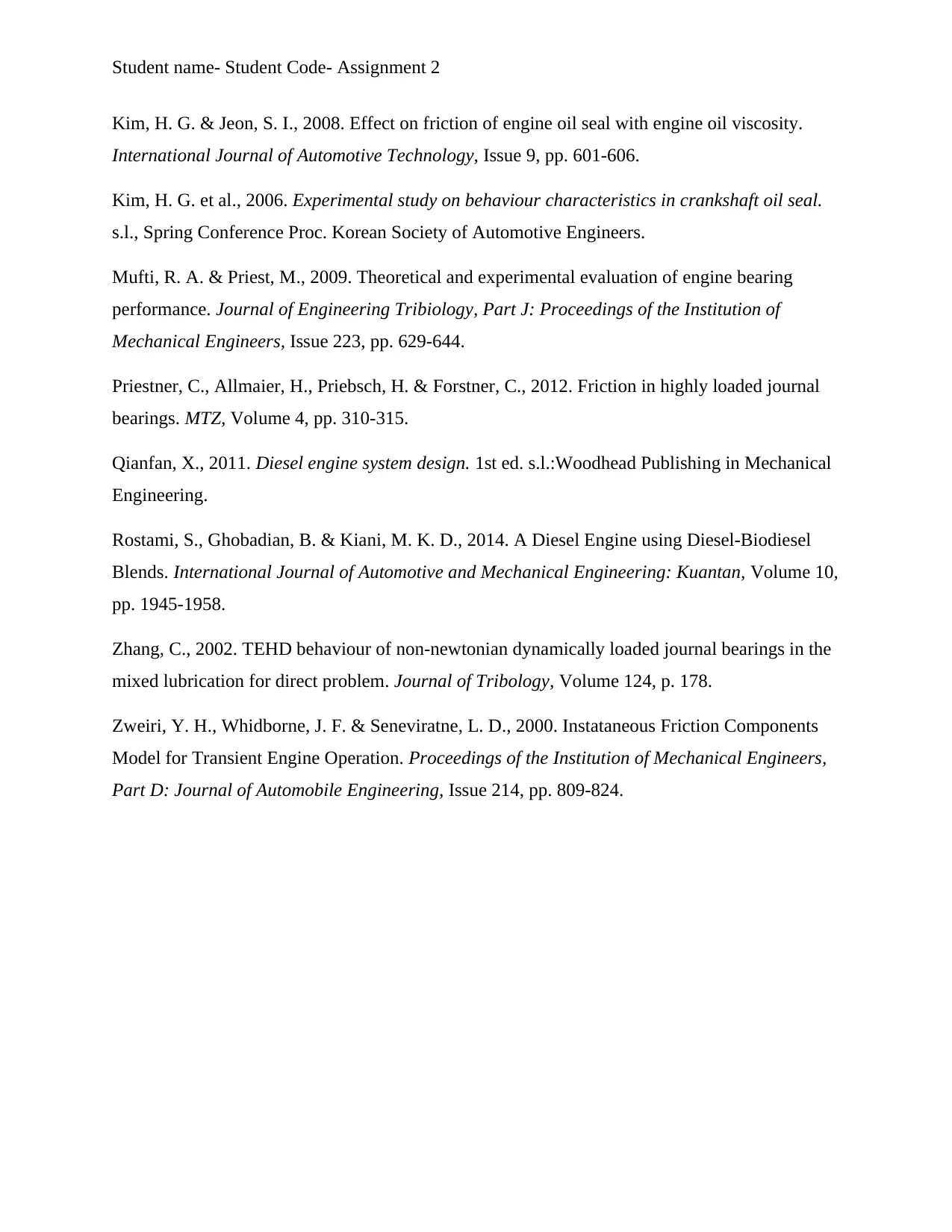
Student name- Student Code- Assignment 2
Kim, H. G. & Jeon, S. I., 2008. Effect on friction of engine oil seal with engine oil viscosity.
International Journal of Automotive Technology, Issue 9, pp. 601-606.
Kim, H. G. et al., 2006. Experimental study on behaviour characteristics in crankshaft oil seal.
s.l., Spring Conference Proc. Korean Society of Automotive Engineers.
Mufti, R. A. & Priest, M., 2009. Theoretical and experimental evaluation of engine bearing
performance. Journal of Engineering Tribiology, Part J: Proceedings of the Institution of
Mechanical Engineers, Issue 223, pp. 629-644.
Priestner, C., Allmaier, H., Priebsch, H. & Forstner, C., 2012. Friction in highly loaded journal
bearings. MTZ, Volume 4, pp. 310-315.
Qianfan, X., 2011. Diesel engine system design. 1st ed. s.l.:Woodhead Publishing in Mechanical
Engineering.
Rostami, S., Ghobadian, B. & Kiani, M. K. D., 2014. A Diesel Engine using Diesel-Biodiesel
Blends. International Journal of Automotive and Mechanical Engineering: Kuantan, Volume 10,
pp. 1945-1958.
Zhang, C., 2002. TEHD behaviour of non-newtonian dynamically loaded journal bearings in the
mixed lubrication for direct problem. Journal of Tribology, Volume 124, p. 178.
Zweiri, Y. H., Whidborne, J. F. & Seneviratne, L. D., 2000. Instataneous Friction Components
Model for Transient Engine Operation. Proceedings of the Institution of Mechanical Engineers,
Part D: Journal of Automobile Engineering, Issue 214, pp. 809-824.
Kim, H. G. & Jeon, S. I., 2008. Effect on friction of engine oil seal with engine oil viscosity.
International Journal of Automotive Technology, Issue 9, pp. 601-606.
Kim, H. G. et al., 2006. Experimental study on behaviour characteristics in crankshaft oil seal.
s.l., Spring Conference Proc. Korean Society of Automotive Engineers.
Mufti, R. A. & Priest, M., 2009. Theoretical and experimental evaluation of engine bearing
performance. Journal of Engineering Tribiology, Part J: Proceedings of the Institution of
Mechanical Engineers, Issue 223, pp. 629-644.
Priestner, C., Allmaier, H., Priebsch, H. & Forstner, C., 2012. Friction in highly loaded journal
bearings. MTZ, Volume 4, pp. 310-315.
Qianfan, X., 2011. Diesel engine system design. 1st ed. s.l.:Woodhead Publishing in Mechanical
Engineering.
Rostami, S., Ghobadian, B. & Kiani, M. K. D., 2014. A Diesel Engine using Diesel-Biodiesel
Blends. International Journal of Automotive and Mechanical Engineering: Kuantan, Volume 10,
pp. 1945-1958.
Zhang, C., 2002. TEHD behaviour of non-newtonian dynamically loaded journal bearings in the
mixed lubrication for direct problem. Journal of Tribology, Volume 124, p. 178.
Zweiri, Y. H., Whidborne, J. F. & Seneviratne, L. D., 2000. Instataneous Friction Components
Model for Transient Engine Operation. Proceedings of the Institution of Mechanical Engineers,
Part D: Journal of Automobile Engineering, Issue 214, pp. 809-824.
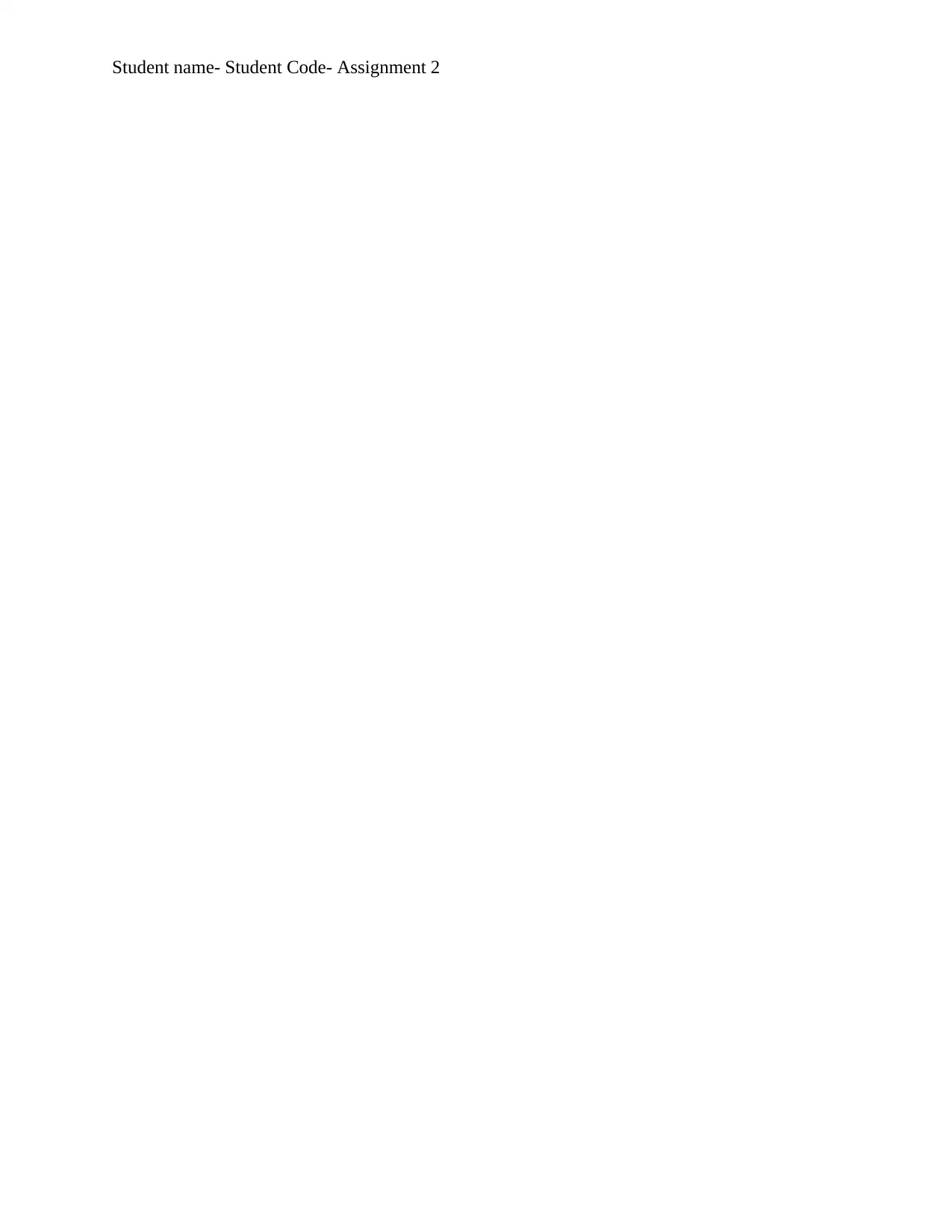
Student name- Student Code- Assignment 2
⊘ This is a preview!⊘
Do you want full access?
Subscribe today to unlock all pages.

Trusted by 1+ million students worldwide
1 out of 9
Related Documents
Your All-in-One AI-Powered Toolkit for Academic Success.
+13062052269
info@desklib.com
Available 24*7 on WhatsApp / Email
![[object Object]](/_next/static/media/star-bottom.7253800d.svg)
Unlock your academic potential
Copyright © 2020–2025 A2Z Services. All Rights Reserved. Developed and managed by ZUCOL.




